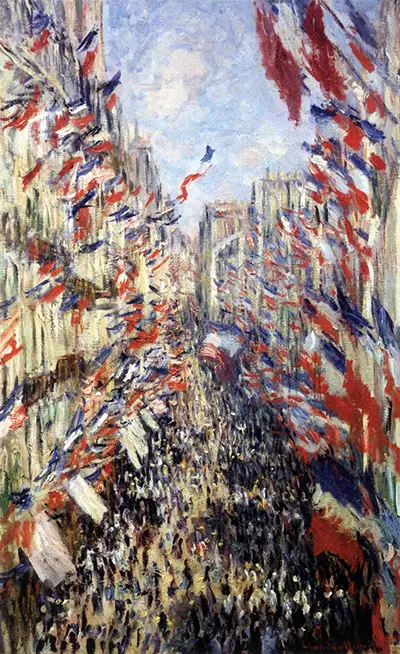The day was declared by the government to celebrate peace and work. In fact, the celebration was organised for the third Universal Exhibition in Paris as an emblem of France’s recovery from the 1870 war.
It also demonstrated national cohesion while strengthening the position of the Republican Regimen, which was rather fragile after the 1876-1877 fall out between conservatives and supporters.
Claude used the impressionism technique to create the painting as it displays the use of small strokes of colour. The emblematic colours are used to paint the crowd that had attended the celebration while the thick strokes illustrate the motion of flags fluttering in the air.
Also, Monet adopts a distanced posture when painting this piece as it brings out an urban landscape of a crowd of people. As such, when viewed at close range, the composition thins out into patches of colour but at a distance, the jubilant street gains a clear focus. Many see comparisons to the cityscapes of Caillebotte.
During the period of 1873-1878, Monet kicked off as an association artist known as Societe Anonyme. However, his work later dominated debates due to his unorthodox exhibition. The use of seascapes christened the group’s name while his style redefined the scope of landscape painting.
His style at the time was considered bold as he captured the transitory effect of different moments instead of painting the geographical features of still objects. The years that followed saw Claude participate in up to five of the eight Impressionist shows - a feat that his fellow artists in the group never attained.
As a result, he launched Impressionism as an avant-garde force in contemporary art. Subsequent years saw Monet present other flash pieces at the Impressionist exhibitions during the group’s trials.
Boulevard des Capucines - This painting adopts the same form as the Rue Montorgueil in Paris Festival of June 30 1878 as Claude takes a high point of view when creating it. He worked on this painting during 1873-1874. It was during this period that the first Impressionist exhibition was held in France. The fair was hosted in a French photographer’s studio, Felix Tournachon, at Boulevard des Capucines. The piece gives you a glimpse of Paris life on a winter day from an apartment balcony. Crowds are seen scuttling through the cold weather bringing out Monet’s indefinable quality of movement with such dexterity.
Autumn in Argenteuil - Claude created the painting in 1873. The piece highlights the crisp colour of the leaves of trees that lingered along the banks of river Seine. It adds to another of Monet’s pieces that brought out his fascination with the weather, seasons, light natural colours and the atmosphere. Each painting ushered in a new aspect. This piece portrays the beauty of autumn season using the flame-coloured trees that cast their image in the reflection of water.
The Poppy Field - The painting was created during the same year as the Autumn in Argenteuil painting. It shows a wildflower field near Argenteuil with spots of red colour. The piece emphasises Monet’s love for colour as he scatters the flowers naturally across the green field. In the forefront, there are vague figures of Jean and Camille highlighted in subtle strokes of white, violet and black. These figures reappear atop some hills located away from the field to re-emphasise the use of colour.


